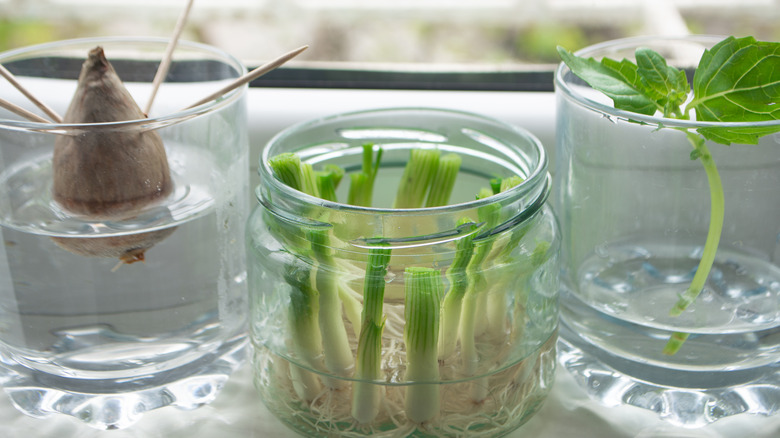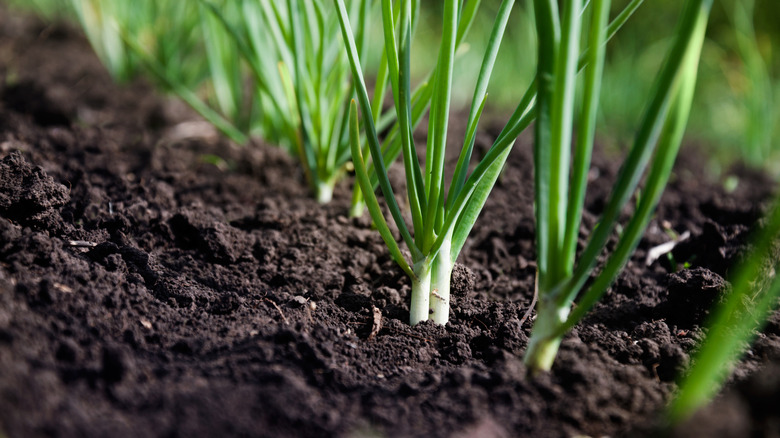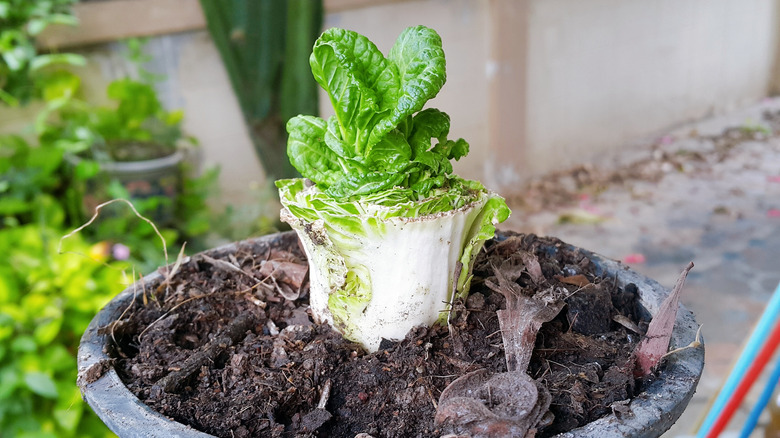Is It Better To Regrow Green Onions In Water Or Soil?
Green onions, also known as scallions, are a type of vegetable characterized by long, slender green stalks and small white bulbs. They belong to the Allium family, which includes onions, garlic, and shallots. Scallions are harvested when they are young, before the bulb fully forms. They have a mild, onion-like flavor and are commonly used as a garnish or ingredient in various cuisines, adding a fresh and aromatic element to dishes. One of the best benefits of cooking with green onions is that the root bulbs can be saved and regrown countless times, providing an endless supply of tasty greens from just one purchase.
Many home chefs take advantage of the ease of regrowing scallions by placing them in a small jar filled with water. While this will allow the green onions to regrow on your windowsill, there are a few drawbacks to keeping them in water. Regrowing green onions in a water glass requires constant water maintenance and changing in order to encourage the scallions to keep growing. Moreover, tap water generally does not contain many of the vital nutrients that the plant needs in order to develop fully. Therefore, consider replanting your scallions in a pot of soil for an even longer life and an endless supply of delicious greens.
Benefits of regrowing green onions in soil
Regrowing green onions in soil offers several advantages over regrowing them in water. While water can support initial growth, transferring green onions into soil provides a more stable and sustainable environment for their long-term development. First, soil provides essential nutrients for plant growth. It contains a rich mix of minerals, organic matter, and microorganisms that nourish the green onions. These nutrients are crucial for plants to develop healthy leaves and roots, leading to stronger and more robust growth overall. While green onions will develop in water, after they reach maturity for a second time, the lack of nutrients in the water will prevent the green onions from developing a robust flavor or sturdy shoots.
Moreover, growing green onions in soil promotes better root establishment. When green onions are placed in soil, the roots have the opportunity to spread and anchor themselves, enhancing their ability to absorb water and nutrients from the surrounding environment. In contrast, growing them in water may result in weaker root systems, which can impact the plant's stability, as well as its capacity to sustain long-term growth. Additionally, regrowing green onions in soil offers greater protection against environmental fluctuations. Soil acts as an insulator, providing a buffer against temperature changes, ensuring consistent moisture levels, and protecting the plants from direct sunlight. This stability contributes to green onions' resilience, reducing the risk of stress or damage caused by external factors.
Other food scraps to regrow in your garden
Aside from green onions, there are plenty of other foods that are easy to regrow from scraps. Romaine lettuce is a versatile and popular leafy vegetable that can be regrown by simply cutting off the leaves about 1-2 inches above the base. Place the base in a container of water with the water covering the bottom inch of the base. After a few days, leaves will emerge from the center. Once the new leaves appear, transplant the lettuce into well-draining soil, and provide adequate sunlight and regular watering.
Celery is another vegetable that can be regrown from its base. After using celery stalks, save the base with about 2 inches of the stalks attached. Place the base in a container with water, submerging the cut end. Keep the container in a well-lit area, changing the water every few days. Within a week or two, new shoots will sprout from the center of the base. Once the shoots have grown a few inches tall, transplant them into soil in a sunny spot.
Though onions can initially grow in water, in order to regrow an onion from a kitchen scrap, you'll need to take an onion with a root end intact and plant the root end directly into well-draining soil, leaving the top exposed. Water the soil regularly to keep it moist. Over time, new shoots will emerge from the onion, and it will grow into a new onion bulb that's ready for harvesting. And if you're looking for more ways to make use of scraps, certain kinds of scraps can rid your garden of creatures like slugs and snails.


